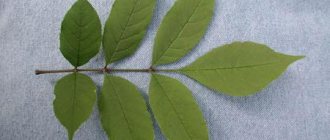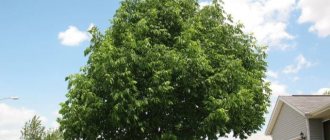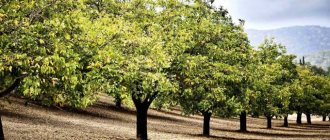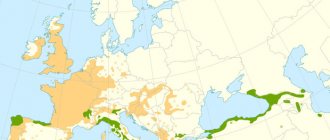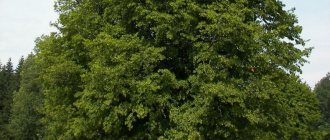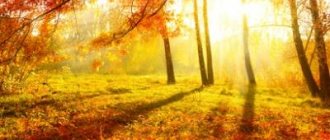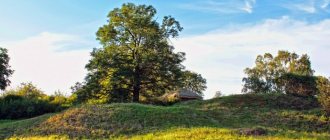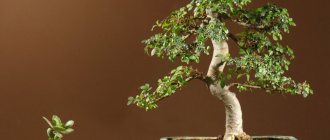The luxurious, majestic ash tree is known throughout the world. A tall, slender trunk and not very dense crown look attractive and elegant.
In Russian, the name of this handsome man comes from the words “light, clear.” The sun's rays penetrate the branches and leaves, and on a fine day the tree looks as if it is permeated with golden reflections. The crown has an openwork appearance. According to ancient beliefs, ash was considered a tree of purity and light. According to Scandinavian myths, life originated from this tree.
Religious objects, sculptures, interesting souvenirs, furniture and household utensils were made from wood. The fruits and leaves of ash have healing properties, which has also been known for a long time. Therefore, they were used to treat and prevent diseases.
General description of the Ash tree
Ash belongs to the Dicotyledonous class of the Olive family.
Despite the huge number of varieties, all trees are classified as one genus with the same name. All types of ash are similar to each other. What does ash look like? Trees with a large root system that spreads far both in width and depth. In different growing conditions, the roots of a tree look different. If the ground is dry and the groundwater is deep, then the ash tree has a clearly visible long taproot with many lateral shoots. If groundwater supplies the soil well with moisture, then the root system develops superficially and has an anchor structure. The tap root is hard to find among the others.
The tree grows well in fertile soils. It loves light, so ash can often be found in clearings or among sparse plantings.
The trunk is smooth and almost entirely covered with smooth light gray bark. Only in the lower part of the trunk can you see a network of small cracks as you approach the ground. The diameter of the tree depends on the place of growth and the age of the ash tree (some specimens live up to 300 years) and sometimes reaches a meter.
What does an ash tree look like? In the photo above you can see that the crown is formed from thick arched branches, which gives it a roundness. The branches are directed upward and have few straight shoots. The crown width is on average 15 meters; in large specimens it can reach up to 25 meters.
In spring, it is easy to determine the type of tree by the structure of the bark and by the black buds, and at the top of the tree they are much larger than on the sides of the trunk. Ash leaves appear late and are bright green.
Planting a tree yourself
It is better to plant ash, which cannot tolerate excessive waterlogging of the soil, on hills or first take care of organizing a good drainage system in an area with low groundwater levels.
The future giant reproduces in two ways: vegetatively and generatively, but it is important to remember that choosing a seedling that quickly takes root is much easier than growing seedlings, which can take a lot of time and effort, but not bring the desired result.
Distinctive features
Ash is used in almost all areas. It is used for the manufacture of:
- medicines;
- sports equipment;
- gun butt;
- paints;
- furniture;
- hives.
The wood of the tree is strong and silky, with a purple or pink tint. It has high viscosity and does not flake. The tree has one drawback - it is that the wood is quickly subject to wormhole, so everything made from ash must be treated with an antiseptic.
Many artists use the roots of the plant, which are very similar to the wood of the olive tree, to make various products and decorations. Ash fruits are also used in cooking; they are used to prepare salads and spices. Unripe fruits are pickled and added to meat dishes.
Interesting Facts
- Ash in common people has several names: holly, ash, ash. In nature it often grows next to oak trees. By watching the trees, you could find out what kind of summer it would be like. If the oak tree shows its leaves first, it means it will be hot and dry.
- The Greeks used the juice of the plant for snake bites.
- In Rus', the bark of the tree was used as a remedy for malaria and fever.
- In magic, ash personifies good and evil; it has powerful energy.
- Many peoples worshiped the tree. It was called the “tree of knowledge” and was considered a symbol of life and wisdom.
We will be very pleased if the reader discovered new and interesting facts about ash in this article. If something was unclear, you can ask questions in the comments below. Our editors will be happy to answer all readers.
You can find out what ash looks like from the video provided:
Physical properties
The physical indicators of ash are quite high. This classifies wood as durable and easy to work with. Expensive furniture and high-quality parquet are made from ash.
Strength
- The tensile strength measured in tension along all fibers of any type of wood is on average 1300 kgf/cm2. But the strength of wood across the grain can be only 1/20 of the tensile strength along the grain. And this figure is 65 kgf/cm2.
- There is another parameter - compressive strength. It also comes in two types - along and across the fibers. With increased compression along the fibers, the dimensions of the wood become shorter. The strength indicator is at least 500 kgf/cm2.
- But when compressed across the fibers, the wood becomes denser and its height decreases. After the mold is destroyed, its side parts peel off. This indicator for ash wood ranges from 90 to 99 kgf/cm2.
Thermal conductivity
- Ash that has undergone heat treatment has the following thermal conductivity index - 0.18 Kcal/mxhx °C. It is 20% lower than that of untreated wood. Quite low thermal conductivity combined with high density allows us to speak of ash wood as a tree that can retain heat. Wood is suitable for creating warm floors.
Density
- There is no average density for ash. Late wood has a density three times higher than early wood. Its level is also affected by the humidity of the tree. The optimal density of ash, whose moisture content is 12%, is measured from 680 kg/m3, and the maximum value is 750 kg/m3. This wood is a high density species.
Elasticity model
- The modulus of elasticity of type 1 ash wood under tension or compression along the fibers is practically the same. In ash, the ratio of these two indicators is 0.9. But the tensile modulus of elasticity will be different.
- This indicator is from 7 to 14 times less for ash when stretched across the grain than along it. And with radial stretching it is 1.5 times higher than with tangential stretching. The model of elasticity during torsion of the second kind in ash is 16 times less than the modulus of elasticity of the first.
Natural humidity
- The ratio of the mass of moisture contained in a specified volume of wood to the mass of the same but absolutely dry volume is called absolute humidity. When the drying process occurs (natural or artificial), the moisture from the cell membranes evaporates and the wood becomes dried out or dry.
- Moisture absorption in ash is much lower than, say, in coniferous trees. This is due to its high density. Thus, a freshly felled common ash tree has a moisture content of 36%. But for Manchurian ash, the humidity reaches 78%. When dried, cracks may form on this wood. Although it is believed that when using drying and processing technology, ash is excellent for parquet production.
Hygroscopicity
- Ash does not absorb external moisture too actively. But in a humid environment, its saturation point can cause some change in volume. That is why dense and hard ash is not suitable for interior cladding of saunas and baths.
Weight
- Pure wood cellulose, the amount of water and the anatomical structure of the tree affect the specific gravity of the wood. For common ash, these parameters may vary depending on how dry the wood is.
- Specific gravity indicators
| specific gravity of freshly cut ash | specific gravity of air-dried ash |
| average 0.92 | average 0.75 |
| limit 0.74-1.14 | limit 0.57-0.94 |
- These indicators allow us to classify ash as a first class of very heavy wood.
- Hardness and strength
- The density of ash wood at a humidity of 12% reaches 700 kg/m3.
The hardness of ash is as follows:
- end - 78.3 N/mm2;
- radial - 57.1 N/mm2;
- tangential - 65.1 N/mm2.
Wood is classified as durable, hard and heavy. Three-dimensional sculptural compositions can be made from it.
Under what conditions does the culture grow?
A young tree has an average growth for the first five years, then develops intensively by 30-50 cm per year. For growth and development, the plant needs loose soil with good drainage. Prefers areas with calcareous, moderately acidic, loamy and clayey soil, with a rich fertile layer.
Interesting! Elm is a very cool tree. Read about him.
Ash is moisture-loving and does not respond well to drought. It is also sensitive to constant waterlogging of the earthen clod and grows slowly on compacted soils. The plant is light-loving and can tolerate light shading and strong winds. In nature, reproduction occurs using root shoots, layering and seeds. The tree is winter-hardy, but young specimens may freeze slightly during late spring frosts.
Ash grows quickly: you need to take this fact into account when choosing a planting site so that the plant does not interfere with other crops and buildings.
Ash - brief botanical information
Ash (Fraxinus) belongs to the Olive family and is translated from Latin as “ash”. The plant has a fibrous root system, the crown is oblong and spreading. In most varieties, the flowers are collected in snow-white inflorescences; in some species they can be purple or burgundy.
For good pollination it is necessary to plant several plants.
Ash flowers have no scent.
The bark of the tree is smooth and light gray in color. An adult plant can reach up to 30 m, but there are species that are giants, up to 60 m in height and 40 m in width. The crown is formed from flexible branches directed upward. The fruits of the tree are long, oblong in shape, on average 5 cm. They ripen in mid-autumn and last until the end of winter.
Lionfish are rounded at the bottom and have a small notch at the top.
All types of ash tolerate severe frosts well, love a lot of light and grow well in neutral-acidic, fertile soil. The tree lives up to 350 years, the first fruiting occurs at the age of 20 years.
Reproduction
This plant can reproduce generatively and vegetatively, i.e. from seeds, or by cuttings or seedlings. If you want to grow trees from seeds, it is better to use last year's seeds.
They should be planted in late summer to allow them to germinate and develop. For planting, you will need to prepare special furrows 5 cm deep. Shoots will appear by May. To care for them, you will need watering and weeding, and loosening the soil 1 – 2 times a month.
Propagation by seeds will require considerable effort and expense. Therefore, this method is only suitable for planting over a large area. And for planting one or three or four trees, it is better to purchase seedlings or cuttings.
Ash: where it grows
The tree is widespread in our country and is found in Africa, North America and the Far East. Here it can be seen in a mixed forest, next to oak, alder and maple. And also along the banks of rivers, next to lakes and artificial reservoirs.
Ash can be found both in parks and squares, and mixed forests
Spreading
This plant is found all over the world. In Russia, ash grows mainly in the southern regions. The beauty and healing properties, as well as the quality of the wood, make it popular. It is used as an ornamental plant to decorate park areas, city alleys, etc. And also as a valuable raw material for industry. In Russia, the most common variety is common ash. It is planted to decorate landscape designs and is also used for the production of wood products.
The structure of culture
The crown is light, wide, rounded. The branches are sparse, thick, gray or gray-green in color, directed upward. The buds are black, without shine, with short hairs, rarely light brown. The apical buds are larger in size than the lateral ones. The bark is smooth, ashen with a gray tint. Mature trees have deep, narrow cracks. The trunk is cylindrical with a diameter of up to 1 m.
The leaves are complex and bloom late. The general petiole is pubescent, consists of 7-9 pointed leaves, which are arranged in pairs, opposite each other. The leaf blade has jagged edges, is smooth on top, dark green in color, fleecy underneath, painted in a light green tone. The leaves grow sparsely, so a lot of light enters through the openwork crown.
Jasna fruits
The flowers of the tree have an unusual structure. In April - early May, red-brown or light purple bunch-shaped panicles with red stamens form on leafless branches. At the same time, growth buds begin to bloom. The flowers have no perianth, and the colorful tufts are odorless.
The fruits are drooping, winged green achenes up to 4.5 cm in length, then turn brown. Ash lionfish are oblong, with a curved wing, collected in clusters of several pieces. The nut is wide, flat, and occupies almost half of the lionfish. Ripens in August. The fruits develop in November.
Ash looks especially attractive in winter. After the leaves fall, the lionfish remain and can survive on the branches throughout the cold months, decorating the leafless tree with luxurious “earrings.”
Diseases and pests
As a result of exposure to unfavorable factors - sudden changes in temperature, lack of nutrients in the soil, improper care, diseases appear, despite their unpretentiousness. Diseases are also caused by insects that infect the plant. These include:
- variegated pine beetle, which damages the trunk and branches, making the wood unsuitable for processing and use;
- narrow-bodied emerald borer - larvae develop under the bark, and adult insects eat the leaves;
- Spanish fly eating tree leaves;
- corrosive woody tree;
- seed-eater-weevil, devouring fruits.
Tree crown foliage
Ash is easily recognized by its distinctive large leaves. They grow up to 40 cm in length and are composed of 7-15 opposite elements. The length of each is from 4 to 9 cm. They are wedge-shaped with a pointed apex. In the center of the ash leaves (photo below) a vein is clearly visible; from the bottom of the leaf it protrudes as a whitish vein. The stalk has a grooved and semicircular shape.
The leaves appear quite late in the spring, and in the fall the tree often sheds them while still green from the first autumn frosts. If the autumn of the year is mild, then the leaves acquire a beautiful bright yellow color.
Planting seedlings
If it is difficult to obtain ash seeds, it is better to purchase a good seedling with a developed root system in advance; dig a shallow hole for it and, for drainage, place drainage materials on its bottom and fill it with a nutritious soil mixture.
The root system of the seedling cannot be completely immersed in the soil; the root collar should rise 15 cm above the hole; supports must be installed along the edges of the hole to which the planted seedling is attached, which facilitates its rapid rooting.
Ash bark and leaves: use in folk medicine
The leaves of the tree have been used in folk medicine for centuries. A variety of decoctions and infusions are prepared from the dried leaves for internal use. You can use medicinal raw materials from dried leaves separately or as part of herbal preparations. The bark of the tree also has medicinal properties, our ancestors also knew about this from ancient times. Medicinal raw materials from dry leaves and crushed bark are used in the following cases:
- In the treatment of obsessive dry cough;
- For diseases of the musculoskeletal system, for joint pain caused by arthritis, arthrosis, rheumatism;
- In the treatment of cardiovascular diseases;
- In the presence of deep non-healing wounds.
Medicinal raw materials made from leaves and bark effectively relieve inflammation, have an antiseptic effect, promote wound healing and tighten scars.
In occult medicine, it was traditionally believed that decoctions and infusions from the leaves “clarified” consciousness, that is, they enlightened thoughts. On the day of Ivan Kupala, folk healers and sorcerers went at midnight to collect medicinal herbs, and always brought with them, among other herbs and leaves. Livestock was lashed with branches to keep them healthy all year round.
Why do we love ash so much?
It is not for nothing that the ash tree has been distinguished among others from time immemorial. There are many reasons for this. The first, very important one, is its beauty and nobility. Ash trees were planted where it was necessary to give a noticeable and extraordinary appearance to a city, village or town. Alleys and parks were planted with ash trees so that later, walking along them, one could enjoy their beauty. This plant has always been deservedly considered and is considered a valuable tree species.
In addition to its external beauty, ash is popular because of its resistance to frost, the negative external effects of poor environmental conditions, exhaust gases, and soil compaction. It is planted along roads.
In addition to the above-mentioned advantages, ash is widely used in folk medicine. Its decoction calms the nervous system, treats dysentery and gout. In addition, it has anti-inflammatory properties, is indispensable for rheumatism, kidney stones, arthritis and is an excellent diuretic.
In spring, ash, like birch, produces delicious sweet sap that can replace sugar for diabetics.
Ash is also loved for its wood, which is very strong and elastic. Since ancient times, warriors made weapons, bows, spears and clubs from it, which withstood military campaigns, participating in even the most difficult battles. In Rus', dishes, rockers, hoops and even wheels were made from it. Modern athletes also use sports equipment made from ash: excellent quality skis, racing oars and gymnastic bars.
Furniture made from this wood is simply magnificent. This wood is easy to process, polishes well and hardly deforms during use. Its grain pattern is very beautiful; it is not for nothing that this wood species was chosen for furniture in the Kremlin Palace.
Origin of the name of the tree
Vladimir Dal believes that the name of the tree comes from the word “clear” (light). He explains this by saying that the crown of the tree is quite sparse, the branches are sparse and a lot of sunlight passes through the foliage.
Fraxinus (the scientific name of the tree) is translated from Latin as spear. Most likely, the plant received this name because of the shape of the leaves, thin and pointed at the end.
Planting and care
Today, many landscape designers use the plant for decorative purposes, planting the tree in various garden compositions.
And although this is a crop without special requirements for the external environment, it should still be planted according to all the rules of agronomy.
Interesting! When the first settlers from Europe left for America, “for good luck” they took with them, as a talisman, branches, bark, and also ash seeds. And this contributed to the further spread of this culture.
To plant a young tree, an open area with plenty of sunlight is required.
You should not risk the seedling and choose a place with high humidity, or acidic and alkaline soils.
- After the planting hole is ready, a drainage layer is laid on the bottom. Then the hole should be spilled with water.
- Install the plant straight; tilting should be avoided. Cover with soil mixture (soil, sand, humus). Compact the hole.
- If it is a group of plants: young trees are planted at a distance of at least 5 meters. For low-growing varieties, 3 m is enough.
New plantings do not bring much trouble. Young plants need to be watered only in severe drought. To make the crown of a tree beautiful and well-groomed, it can be trimmed. This procedure is performed in early spring. Manure or ready-made nitrogen-containing mixtures can be used as fertilizer.
Types of ash
common ash
The edge of its leaf plates is characteristically carved. The height of the trunk can exceed 30 meters. While the ash tree is young, the bark of its trunk is colored greenish-gray. Over the years, it becomes dark gray, and cracks appear on its surface. The black buds are decorated with small specks.
The tree blooms in March, with foliage appearing later than flowers. This plant is a long-liver; it can live for more than three hundred years. At the same time, its wood is highly valued in the woodworking industry.
American ash
The front surface of its leaf plates is lighter in color than the back. They are similar in shape to walnut leaves, but their wedge-shaped tips are slightly more pointed. Flowering early. Buds on the branches form in the first days of April. The tree is not resistant to drought.
Black Ash
Its thick bark is dark in color. This frost-resistant plant has no flowering at all.
White ash
Its second name is “semolina ash”. This plant can reach a height of up to 20 meters. The shape of the crown can be ovoid or round. If you cut a branch, manna will appear at the cut site, which is sap that solidifies in the open air. It is because of this sap that the tree is called white. It is widely used in the pharmaceutical industry.
During flowering, spectacular white panicle-shaped inflorescences appear on the branches. Since this plant is very beautiful, it is often used as an ornamental crop for gardens, parks, etc.
Manchurian
As you can easily guess from the name, this species came to our country from Manchuria, China, Japan and Korea. Grows in forests, on nutritious soil, next to Japanese elm and Maksimovich poplar. The centenarian grows up to 350 years.
The tree is dioecious and when flowering is covered with flowers of different sexes. The variety has an erect trunk, from which the branches diverge obliquely. It reaches a height of up to 35 m, and a diameter of up to 15 m.
Manchurian ash has a specific shape and type of leaf
The bark is brown or ash-colored and has small cracks and longitudinal ribs up to 5 cm thick. Flowering begins in May and continues until September. In place of flowers, fruits appear - lionfish, which last until spring. At the ripening stage they are olive-colored.
Flat lionfish acquire a brown tint towards the end of ripening
Pennsylvanian
Pennsylvania ash, or downy ash, grows up to 25 m in height. Young branches are felty and covered with dark brown bark. The leaf blade is imparipinnate, consists of 9 leaves of a dark olive color, which by autumn do not change their color and turn green. The inflorescences are pale green, without aroma.
The species is fast growing, gaining about 50 cm in height and 30 cm in width per year. Lives up to 350 years. Ash grows in fertile soil and a sunny place. Although the variety is frost-resistant, it is not recommended to grow it in the northern regions.
The plant prefers moisture and therefore needs regular watering.
Chinese
Chinese ash, or ailanthus, is a light-loving palm-shaped plant native to Northern China. It grows throughout Russia and is widely used for landscaping populated areas. The trunk is gray-brown in color with a furrowed structure of thin bark. The leaves are large, very similar to palm trees, reaching a length of up to 60 cm. Yellow-green flowers are collected in large panicle inflorescences. Flowering begins in mid-summer. After the flowers, small red-brown fruits are formed, which stand out against the background of olive foliage.
Ash flowers emit a not entirely pleasant aroma
This type of ash is fast-growing; by the age of five years the tree reaches 5 m. Chinese ash, or the tree of the Gods, loves a lot of light and warmth. At a young age, the plant is not frost-resistant, but the frozen crown is well restored due to the rapid growth of young shoots. Thanks to its powerful roots, the plant can grow in an open, windy area.
In medicine, due to the rich chemical composition, leaves, bark, flowers and fruits are used. Fresh bark treats dysentery, flowers and foliage treat scarlet fever and diphtheria, and the fruits are prescribed for diseases of the genitourinary system. The leaves have antiviral and antimicrobial properties. The leaves are used to make decoctions that are taken to treat fever.
The bark and leaves have irritating properties; when collecting raw materials, a pustular or blistering rash may appear.
Chinese ash is unpretentious to grow and grows well in moist loamy soil.
Fluffy
This tree is the shortest of all ash varieties, its height is no more than 20 meters. Its crown is openwork, spreading, and its shoots are felt-like. Hence the name - fluffy ash. It can even grow where the soil is thoroughly flooded. The second name for downy ash is Pennsylvanian.
Most often this species grows in North America. It is absolutely unpretentious to the soil, so it grows along rivers or even in flooded openings. The leaves of the tree consist of 5-9 leaflets. Belongs to the category of frost-resistant trees.
A worthy exhibit for the garden
When creating a landscape interior on a personal plot, it is important to give a special place to ash. It will fit perfectly into the local garden color, and most importantly, it will delight all its neighbors with its grandeur and beauty. The choice of a specific type of breed should depend on the goals pursued by the gardener. Here are some of the options:
- tall specimens with a pyramidal crown are suitable for monumental/single exhibits;
- low-growing, horizontal and spherical varieties are a godsend in creating hedges;
- Weeping varieties, the branches of which are unusually curved, like those of a willow, will add extravagance to the garden.
To plant these amazing ash trees, you need to find a flat area and preferably without shady places. However, the soil should be sufficiently moist, but without the formation of stagnant water. After all, these plants tolerate droughts and frosty winters without problems. The key to active and successful development of a tree largely depends on planting a seedling.
You should avoid planting ash in saline areas. You can give preference to areas with a high calcium content. In this case, the acidity of the soil should vary within 6-7 pH.
Soil Features
When purchasing a seedling, you need to pay attention to what form it is in. The roots should be hermetically sealed with an opaque material or in a container. Before planting, you should soak the rhizomes, saturating them with moisture. In turn, the hole will need to be made 33% larger than the earthen ball of the seedling’s rhizomes. The fourth part of it should be filled with drainage, consisting of:
- crushed stone;
- pebbles;
- coarse sand.
Thanks to this “cushion”, each layer of soil will dry out evenly. Moreover, there will be no seals on which salt formations settle. Moisture will not be able to accumulate in the roots, which can lead to souring and rotting. The composition of the soil substrate should include:
- one part sand;
- two parts of humus;
- 1 teaspoon of deciduous soil.
After this, the area around the trunk must be covered with mulch (layer height - 15 cm). It can consist of either peat or wood chips. The first four days the seedling needs abundant watering. If possible, the area should be weeded, deepening the hoe no more than 7 cm.
Nitrogen-containing fertilizers are recommended to be applied in early and late spring. In the autumn, the plant can be fed with solutions of Kemir (universal) or nitroammofosk. In winter, you need to wrap the trunk with burlap. Such precautions apply only to 3-year-old copies.
It is worth considering that loose soil will certainly sag after planting. For tall trees this is a disaster. Therefore, the roots need to be planted 10-20 cm above the horizon.
The mighty ash tree also has many enemies. These include the bark beetle, ash blight, and branch/trunk cancer. Growths, rot and other formations can be safely removed by treating the wounds with an activated carbon solution. All other pests must be eliminated using insecticides. As a result of such careful care, the ash tree will grow large (up to 5 meters at home) and healthy.
Use of woody plants
Areas of use
The main advantage of the crop is its durable and flexible wood, which is widely used in the furniture industry and aircraft manufacturing, and serves as a material for the manufacture of garden tools, sports equipment, some parts of weapons, railings, window frames and parquet. Natural wood has a very beautiful light pink or yellowish tint, giving the room a unique look. In the production of musical instruments (guitars and basses), ash is chosen by both the world's largest brands and small firms.
The bark and leaves are used to make brown, blue and black dyes. Ash root has a very beautiful texture. It is used to make plywood and veneer. Beehives are made from the bark of large trees. Dry and fresh leaves are fed to livestock. Small original crafts are made from growths on wood (burls).
The buds, roots, flowers, leaves, seeds and fruits of the tree are used for medicinal purposes. In some countries, canned fruits are eaten and used as a savory seasoning for vegetables and meat. Dried juice (manna) is a valuable substitute for industrial sugar.
Ash is a favorite breed of magicians and healers. Its pure, subtle energy aligns the psyche, develops clairvoyance abilities, and can show the future. Ash amulets protect the owner from negative energy. The wood is used to make fortune-telling runes. The power of the flame of ash wood has healing properties and has a beneficial effect on the state of mind. A fire lit at Christmas promotes prosperity. Ash leaves help to attract love, scattered in the four corners of the house - they will protect against evil forces. Finding a leaf with the same number of teeth on both sides brings good luck.
Landscape design
The plant attracts designers with its elegant, slender trunk and lush crown, which creates a light and airy atmosphere in the garden. An ash tree looks spectacular when planted alone, fully revealing the beauty of the leaves and the texture of the bark. As a background plant, it emphasizes the brightness and expressiveness of many ornamental shrubs and flowering perennials.
In combined plantings it is ideally combined with larch, rowan and linden. As the trees grow, they form one lush decorative crown. Willow and maple get along well with ash. It grows poorly next to the representative of Beech trees - oak. Planting several types of ash in one area looks impressive. Weeping forms are good along the banks of artificial reservoirs, along paths, and as canopies over gazebos and benches.
You can alternate the crop with coniferous plants (spruce, pine, thuja, junipers). More contrasting compositions are obtained from ash varieties with yellow foliage and gray, silver or blue needles. The original shape of the leaves and lionfish will stand out against the background of evergreen crops.
The main thing when arranging seedlings into decorative groups is to take into account the density and diameter of the crown of an adult plant, the speed and period of its final formation. This will allow you to accurately determine the distance between the designed plants. Ash has a medium-density crown, so shade-loving, unpretentious crops are planted nearby.
Medicines and folk remedies
The substances contained in the leaves and fruits of ash have many beneficial properties. Dried raw materials are used to prepare medicinal decoctions and infusions, and added to herbal preparations. Essential oils from the fruits of the plant have a detrimental effect on fungi and bacteria. In Germany and Switzerland, antirheumatic drugs based on ash are produced. The food supplement "Revmavit" includes tree bark extract.
In folk herbal medicine, crushed bark and leaves are used: in the treatment of nervous system disorders;
- for cardiovascular diseases;
- to increase male strength;
- for liver and kidney diseases;
- in the treatment of dry cough;
- as a diuretic;
- with pneumonia;
- for joint pain;
- with bleeding;
- for dysentery.
Chronic polyarthritis is treated with crushed seeds. Apply bark or crushed fresh leaves to cuts and shallow wounds. An alcoholic tincture of the fruit is used for varicose veins. Powder from dry leaves is used for inflammation of the pancreas.
However, despite all the positive properties, the plant is poisonous. Folk remedies based on ash are contraindicated for hypertension; herbal preparations are not prescribed for severe atherosclerosis. When planting a tree in your summer cottage, keep in mind that pollen is a strong allergen that can cause contact dermatitis.
Characteristics and application of wood
Ash wood is highly durable and has a beautiful contrasting texture. The sapwood bends well. Growth rings, wavy curling, different densities of early and late layers and differences in color within one log provide the material with an original beautiful pattern. The surface of the cuts is matte, ash does not have a pronounced shine.
The density of wood is about 680 kg/m³; ash is superior to oak in terms of strength . It is not easy to split or process wood with hand tools due to its hardness and uneven anatomical structure. However, this material perfectly holds different types of fasteners: nails, staples and screws.
Biostability is much superior to other types of wood. With age, resistance to fungal and other pathogens increases.
Disadvantages include severe drying during processing and possible swelling during operation. For this reason, lumber requires careful protective treatment. In addition, the high density of ash prevents uniform staining of the fibers with tinting agents. But properly dried and prepared material is durable - it lasts for many years without deformation.
Ash wood of Russian origin can sometimes suffer from internal rot due to the formation of frost cracks in old trunks.
In ancient times, tools, clubs, spears, bows, arrows and stakes, used in hunting and battles, were made from durable ash wood. The boards were used in shipbuilding, the production of sleighs and carriages, utensils were turned from the wood, rocker arms and wheel rims were bent, and clamps and ax handles were made.
In modern industry, ash is used to cut veneer, parquet, produce bent and carved furniture, sports equipment, elements of loom mechanisms, and gun stocks.
The beautiful variegated pattern and matte silky surface of an array of ash trunks and roots are of artistic value. The material is used for turning various figures and sculptures.
Bark and foliage are also used for technical purposes. Dyes, tanning solutions, and natural medicines are made from them. In rural areas where ash is common, the leaves are used to feed livestock.
Treated ash wood should be stored correctly. Before stacking, lumber should be sorted by size. It must be arranged in such a way that air can penetrate inside. This will ensure even drying of the ash wood. Do not leave the stack in the open. It may be susceptible to moisture penetration. This will worsen the condition of the wood. Treated wood should be laid under awnings or covered with roofing felt. Ash wood is resistant to fungal growth during storage, but is susceptible to cracking.
But ash is also popular in the countries of Abkhazia and Georgia as an additive to some types of dishes. The people of these countries love to add healthy herbs and leaves to their food, using them as seasoning. Ash fruits along with seeds are added to meat and fish dishes, salads, and stewed with vegetables.
In some European countries, the bark of this tree is added to medicines. It is used in cosmetology, as an additive in shampoos. Juice is extracted from some ash trees. Most often, the flower species of this tree is used for this. The juice is part of the pharmacopoeia.
In England, it is customary to collect still unripe fruits from ash trees. They are marinated in a special solution of pepper, salt, and vinegar. This substance can then be crushed and used as a seasoning. The resulting component can easily replace natural capers. In the Caucasus, this fruit is also processed in spicy seasonings. It acquires a unique taste, has a tonic effect, and is added to main dishes.
Mythological ash
This tree has been loved by man since ancient times. Many ancient people even believed that their ancestor was the ash tree. A description of this interesting judgment can be found in the poem “Works and Days” by the ancient Greek poet Hesiod. It is on the pages of his work that it is said how the ancient Greek gods found two trees: ash and alder - and created from them, respectively, a man and a woman, endowing them with body, soul, feelings and mind. Even in the paradise of Ancient Greece, ash continues to live and delight those who come to this place with its beauty.
In Lithuania, this tree symbolizes a righteous and pure life. Ash appears in Lithuanian fairy tales, legends and stories. In addition, many peoples treated ash very favorably, loving and honoring this tree. Perhaps only the oak tree surpassed him in power, but not in beauty.
The beauty of the tree and ash leaves (photo presented in the article) has long been liked by people. In ancient legends you can find myths about the involvement of ash in the appearance of people on Earth. The Scandinavian gods - Odin, Vili and Ve - created a man from ash and a woman from alder. God Odin breathed a soul into them and gave them life, the next god Vili gave them reason and taught them to move, and the last god Ve infused them with 5 senses.
After death, warriors who fell on the battlefield (in the beliefs of the ancient Scandinavians) end up in Odin’s Garden of Eden, where they continue their military work. In the middle of the promised land called Valhalla stands a huge ash tree. A goat that eats its leaves produces a full cup of honey every day instead of milk. And a deer eating its branches has an inexhaustible source of water flowing from its antlers, which flows underground.
Historians believe that ancient beliefs are closely related to the properties of white or semolina ash, which releases sweet sap from its branches when cut.
Mention of white ash in the Bible
Some historians express the opinion that white ash is related to the biblical legend about manna from heaven, believing that this particular type of ash was the source of manna. This has become the subject of heated debate among various researchers. Many believe that it is because of this that this ash tree received its botanical name.
Sources
- https://sadovnikam.ru/475900a-yasen-foto-dereva-i-listev-opisanie-raznovidnosti-i-interesnyie-faktyi
- https://pion.guru/derevya/yasen
- https://agronom.guru/yasen-foto-dereva-i-listev
- https://kursi-floristiki.ru/recepty/yasen-derevo-foto.html
- https://rostok.guru/derevya/yasen-gde-rastet-i-kak-vyglyadit-foto-i-opisanie.html
- https://vserastenija.ru/yasen-obyknovennyj/
[collapse]
